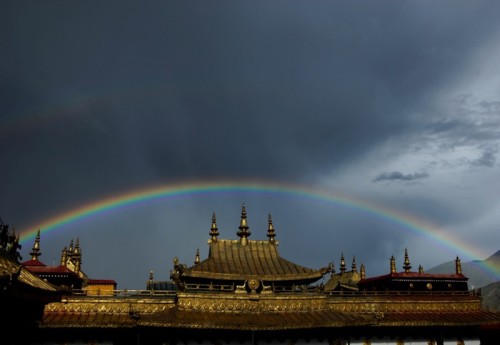A temple, shrine or monastery sits at the heart of almost every community on the Tibetan Plateau. Jo James steps inside to learn more…
 Continue reading
Continue reading
Detours BlogDetours - Inspired by the world's back roads |
Posted on 27 Aug, 2018
A temple, shrine or monastery sits at the heart of almost every community on the Tibetan Plateau. Jo James steps inside to learn more…
 Continue reading
Continue reading Posted on 13 Mar, 2018
There may be plenty to choose from, but we’ve managed to settle on a few spectacular favourites…
Posted on 16 Jan, 2018
From the windswept traces of ancient trade routes to thriving modern marketplaces, the story of commerce in Tibet is a fascinating one. Joanna James finds out more…
Posted on 1 Dec, 2017
Tibet is a richly rewarding place to travel. While there’s always more to discover, we have learned a lot in the last nine years of organising and leading journeys on the Tibetan Plateau.
Here is our guide for first-time visitors…
Posted on 30 Nov, 2017
This time four years ago, we were exploring a remote and ruggedly beautiful part of China’s Sichuan Province. Joanna James remembers an epic day on the road…
Posted on 25 Aug, 2017
Whether you’re on the fringes of the Tibetan world in Yunnan or Sichuan,
travelling amongst Qinghai’s yak herders or heading for Tibet’s “big city”, Lhasa, make sure that you leave time for the following, our top ten Tibetan experiences…
Posted on 4 May, 2017
Faces from the Land of Snows
Many of us are nervous when it comes to taking a stranger’s photograph, but portraits often provide the best memories – and the most striking images – from a trip. Professional photographer and our photography coach, Ron Yue presents some of his favourite portraits from Tibet…
|
When travelling on the Tibetan Plateau, one of the most striking things is how devout most people are. Their Buddhist faith decides and drives many aspects of everyday life. The lady with the beautiful coral earrings (below) was pausing mid-kora (prayer circuit) on the Barkhor in Lhasa. To the uninitiated, the Barkhor’s foot traffic seems unceasing, but to Tibetans it is punctuated with holy places and tiny shrines, spaces to stop, reflect and pray.
The Barkhor is Lhasa’s religious heart, but the city is also ringed by great monasteries, each with its own tradition of learning. Here, at Sera, young monks gather each afternoon to debate scripture. Each point is illustrated with a dramatic flourish – the clapping of hands, the stamping of feet and the striking down of their opponent’s point.
These scenes are repeated – with local variations – acoss the Tibetan Plateau, from Yunnan to Ladakh. Below, a lady prays with a mala (a string of 108 prayer beads) wrapped around her fingers, in the dawn light outside the Ganden Sumtseling Monastery, a thousand kilometres east of Lhasa.
It is not just the elderly that follow Buddhist traditions. In fact, many pilgrimages are so strenuous that only the young can attempt them. Below, a teenagerl prostrates herself on the Barkhor kora. After I shot this photograph she stood up, moved two paces forward and lay down again, measuring the length of the circuit with her body. She will complete the kora 108 times like this before her pilgrimage is complete.
Not all religious practices are so arduous though – for the onlookers at least! Below, a man picked from the crowd at Gyantse’s Saga Dawa celebrations is covered with flour by a clown. These clowns are tasked with keeping the audience amused, against a backdrop of solemn religious dances.
Far from Tibet’s towns and monasteries, a nomadic lady (below) welcomed us into her black yak-hair tent. Once common, nomads’ camps are becoming harder to find, as the government encourages the drokpa to move into permanent housing.
As a photographer, these final two images are among my favourites. A young boy in Shigatse shows me how it’s done…
…and a lady decked out in beautiful turquoise and coral jewelry takes a quick snap in Yunnan:
Each time I travel in Tibet I find new inspiration from its incredible landscape and wide open skies, but it’s the memories of connecting with people here that I always remember most fondly. What a special part of the world! |
Our journeys in the Land of Snows…  From Lhasa to Mt. Everest Base Camp… Where do we go? Day 1: Arrive in Kunming What you will discover ⦁ Lhasa, the capital of Tibet with the Potala Palace and the holiest Tibetan temple, the ⦁ Visit the old towns of Gyantse and Shigatse ⦁ Drive along Lake Yamdrok and Lake Namtso, the two holiest lakes in Tibet ⦁ Enjoy an unforgettable view Journey Dossier
————————————  Our ALL NEW, UNIQUE journey from subtropical Lao to the Himalayas…
Where do we go? Day 1: Arrive in Laos What you will discover ⦁ Drive from charming Luang ⦁ Highlights include: Luang Prabang, Xishuangbanna, Meili Snow Mountain, Ranwu Lake, Lhasa and much more in between Journey Dossier ————————————
 Our most magnificent photography trip in Tibet
Where do we go? Day 1: Arrive in Kunming What you will discover ⦁ Lhasa, Mt. Everest, holy lakes, adventure, blue skies, snow-capped mountains, red-robed monks, the Jokhang, the Potala, open roads…a journey for *your* life time! ⦁ Learn how to see beauty and capture moments with Master Photographer Ron Yue and Journey Dossier Stories |
Posted on 13 Apr, 2017
The Yarlung Tsangpo is Tibet’s most important river. We take a whirlwind trip down its course…
A raindrop (or, more likely, a snowflake) falling near Mount Kailash in could have one of three fates. If it lands to the north or west of Tibet’s holiest mountain, it will trickle into the Indus, flow across Ladakh, down the length of Pakistan and into the Arabian Sea. Fall to the south of the mountain and it will promptly cascade out of Tibet into Nepal, and – joining the Ganges – run across northern India, draining through Bangladesh into the Bay of Bengal. Finally, if it lands east of Kailash, our raindrop will join the Yarlung Tsangpo.
|
Tibet’s most important river, the Yarlung Tsangpo flows east across Tibet for two thousand kilometres before it finds a way through the Himalayas and pours into India, where it is known as the Brahmaputra, “Son of Brahma”. A journey along the Yarlung Tsangpo is a journey through Tibet’s most dramatic landscapes as well as through Tibetan history. The young river meanders out of Tibet’s far west through sand dunes in a beautiful and rugged land. Although few live here now, this was once part of the Zhang Zhung kingdom, a pre-Buddhist civilisation that has left a handful of enigmatic ruins and soot-blackened caves near Mount Kailash.
In flowing through more populated regions, our river performs a new purpose. The rocky riverbanks are marked with white ladder-like symbols, showing that a water burial has been held recently. Although Tibetan sky burials are well-known, poorer people more often wrap their dead in cloth and slide the bodies into the river – one important reason why Tibetans do not eat fish.
|
Explore Tibet with our journeys… Lands of Silk & Snow: From Luang Prabang to Lhasa ALL NEW, UNIQUE journey from subtropical Laos to the Himalayas Where do we go? Day 1: Arrive in Laos We also offer shorter version of this journey – 10 & 13 Days What you will discover ⦁ Drive from the charming
Luang Prabang to Lhasa in
Tibet… ⦁ Highlights include: Luang
Prabang, Xishuangbanna, Meili Snow Mountain, Ranwu Lake (然烏湖), Lhasa and much more in between
Journey Dossier – – – – – – – – – – – – – – – – – – – Roads on the Roof of the World From Lhasa to Mt. Everest Base Camp Where do we go? Day 1: Arrive in Kunming What you will discover ⦁ Lhasa, the capital of Tibet
with the Potala Place and the
holiest Tibetan temple, the Jokhang temple ⦁ Visit the old towns of Gyante and Shigatse
⦁ Drive along lake Yamdrok and Lake Namtso, the two holiest in Tibet
⦁ Enjoy an unforgettable view
over the Himalayas and drive
right to the Mt. Everest Basecamp Journey Dossier Stories on Tibet A Glimpse of Everest |
*Botanist Frank Kingdon Ward had this to say about a trip here in the 1920s:
Not only is Pemako extraordinarily difficult to reach from any direction, it is still more difficult to penetrate and explore when reached. Surrounded on three sides by the gorges of the Tsangpo, the fourth is blocked by mighty ranges of snow mountains, whose passes are only open for a few months in the year. Beyond these immediate barriers to east, west and south are trackless forests inhabited by wild unfriendly tribes… Add to this… a climate which varies from the subtropical to the arctic, the only thing common to the whole region being perpetual rain, snakes and wild animals, giant stinging nettles and myriads of biting and blood sucking ticks, hornets, flies and leeches…
The Riddle of the Tsangpo Gorges, Kingdon Ward, 1926
